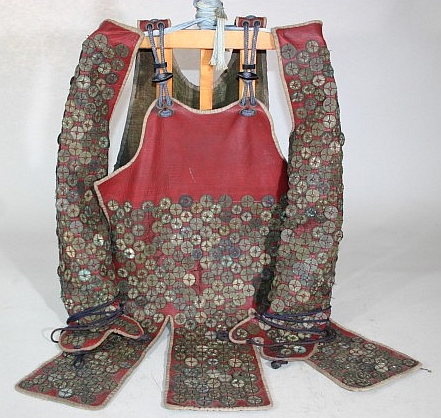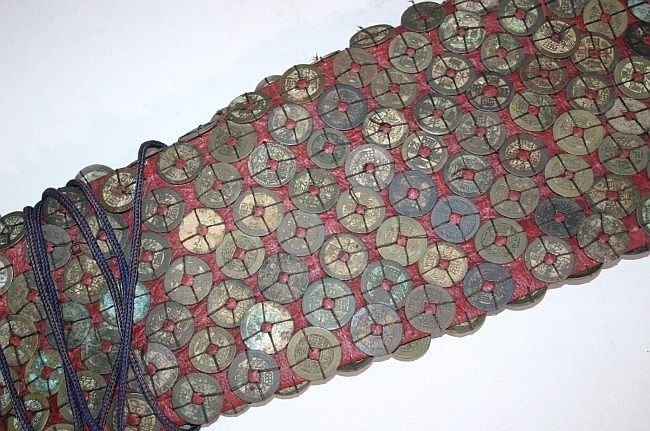I came across the following colour picture of the ring armour in George Cameron Stone's "A Glossary Of The Construction, Decoration And Use Of Arms And Armour" book whilst browsing the Metropolitan Museum's website.
I thought all of the armour enthusiasts out there would like to see a high quality colour pic.
http://www.metmuseum.org/collections/search-t...s/40006114
The Met states it is Tibetan dated to 1744 AD.
Has this piece of armour been published or discussed by scholars in any detail at all?
From what I've read ring armour is quite rare and was never used in Europe.
Are there any other know authentic examples of ring armour?
I believe there is some Inuit & Tlingit armour that uses a leather backing and coins, not sure if this is classed as ring armour or maybe scale armour?
There's an article about mail and ring armour over at "The Arador Armour Library" website:
http://www.arador.com/articles/chainmail.html
Danny
| Danny Grigg wrote: |
| I came across the following colour picture of the ring armour in George Cameron Stone's "A Glossary Of The Construction, Decoration And Use Of Arms And Armour" book whilst browsing the Metropolitan Museum's website.
I thought all of the armour enthusiasts out there would like to see a high quality colour pic. http://www.metmuseum.org/collections/search-t...s/40006114 The Met states it is Tibetan dated to 1744 AD. |
Very cool I've never seen a colour photo of that.
| Quote: |
| Has this piece of armour been published or discussed by scholars in any detail at all? |
Not recently. Maybe when it was first found. Need to dig up the original reports.
| Quote: |
|
From what I've read ring armour is quite rare and was never used in Europe. Are there any other know authentic examples of ring armour? |
I haven't found any.
| Quote: |
| I believe there is some Inuit & Tlingit armour that uses a leather backing and coins, not sure if this is classed as ring armour or maybe scale armour? |
It is usually classed as "bezanted armour". It is like scale armour except the discs don't overlap. I've also seen that type referred to as a "pennyplate coat" but have no idea whether that term was used at the time or not.
Japanese ring armor made with coins.
 Attachment: 151.15 KB
Attachment: 151.15 KB

 Attachment: 201.84 KB
Attachment: 201.84 KB



That would be an example of bezanted armour but there is bugger all difference. Make the hole large enough in the discs and it becomes ring armour.
| Dan Howard wrote: |
| That would be an example of bezanted armour but there is bugger all difference. Make the hole large enough in the discs and it becomes ring armour. |





Here is a European example of this sort of armour:
http://manuscriptminiatures.com/westminster-p...xxii/1424/
(On the lower legs.)
http://manuscriptminiatures.com/westminster-p...xxii/1424/
(On the lower legs.)
| Jojo Zerach wrote: |
| Here is a European example of this sort of armour:
http://manuscriptminiatures.com/westminster-p...xxii/1424/ (On the lower legs.) |
I used to agree that this was the case, but am now dubious. The scalloping on the back of the calf seems extreme for a fabric or leather base that the rings would have to be mounted upon, but is commonly depicted on open-back mail chausses during the early to mid-13th century. It now seems more probable to me that this represents larger mail rings, as stylistic in representation as the rows of commas used in the hauberk.
On another note, the sequin was originally a small coin, and look at it's current interpretation.
| Mart Shearer wrote: | ||
I used to agree that this was the case, but am now dubious. The scalloping on the back of the calf seems extreme for a fabric or leather base that the rings would have to be mounted upon, but is commonly depicted on open-back mail chausses during the early to mid-13th century. It now seems more probable to me that this represents larger mail rings, as stylistic in representation as the rows of commas used in the hauberk. On another note, the sequin was originally a small coin, and look at it's current interpretation. |
How would the scalloping preclude it being a cloth or leather backing? You can see where the rings stop and just the backing is exposed. We also have effigies showing scalloped lacing on surcoats, which would obviously be cloth.
http://effigiesandbrasses.com/monuments/john_...770/large/
I would simply interpret that miniature as an attempt to represent three different types of mail. The scalloping is exactly what happens when you fasten unsupported mail around the calf with a series of ties.
Here is another "ring or bezanted armor", a pair of Japanese (samurai) han kote (gauntlets), they are lined with some type of small metal disks with holes in the middle, the disks are each sewn into individual compartments between layers of cloth. I believe the disks are coins like the other armor I pictured, when I purchased these I assumed the metal plates were kikko armor (hexagon plates), some time later when I had a chance to examine them I realized that the plates were round and not connected to each other, they also had a rather large hole in the middle of each plate, but without making a hole in the lining I can not be sure that the plates are coins and not round metal washer like disks.
[ Linked Image ]
[ Linked Image ]
Page 1 of 1
You cannot post new topics in this forumYou cannot reply to topics in this forum
You cannot edit your posts in this forum
You cannot delete your posts in this forum
You cannot vote in polls in this forum
You cannot attach files in this forum
You can download files in this forum
All contents © Copyright 2003-2006 myArmoury.com — All rights reserved
Discussion forums powered by phpBB © The phpBB Group
Switch to the Full-featured Version of the forum
Discussion forums powered by phpBB © The phpBB Group
Switch to the Full-featured Version of the forum